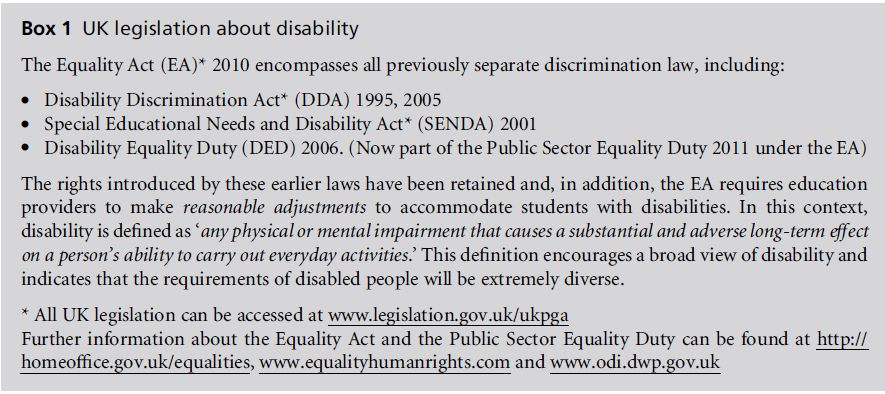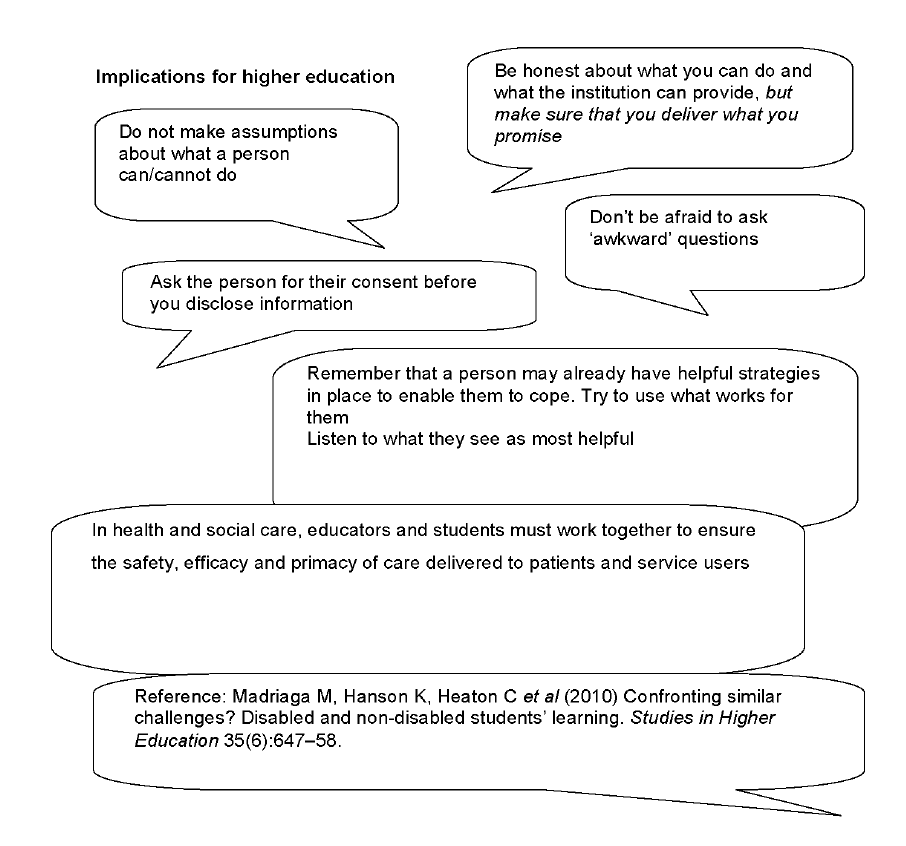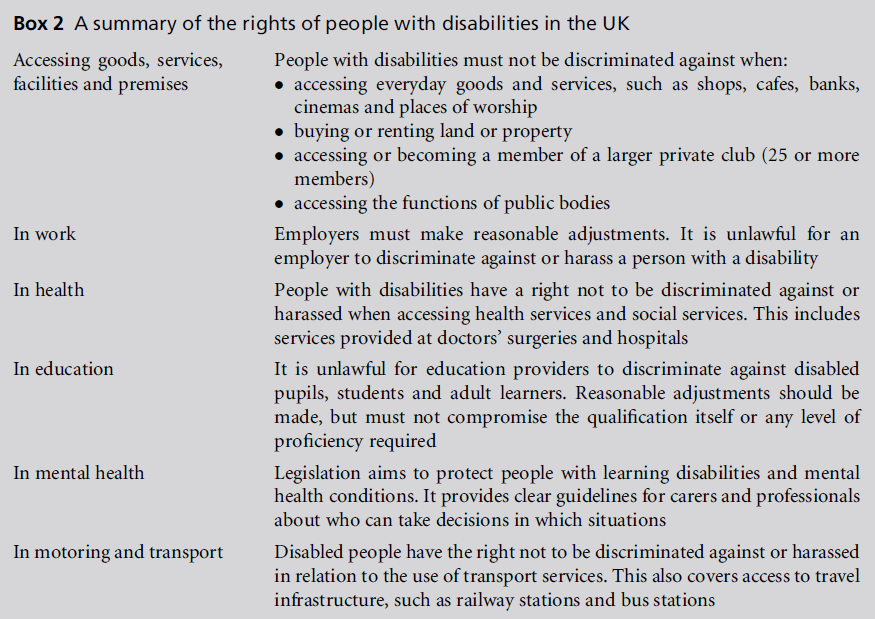Introduction
Some disabilities are highly noticeable and easy to identify. Obvious examples might include people with mobility difficulties using aids or wheelchairs, and visually impaired people using long canes or being assistedby a guide dog.These visual clues bring disability to our attention and tend to evoke a number of different responses based on people’s willingness to accommodate differences in others. Responses may range from making adaptations and adjustments with relative ease, to stereotyping, through to indifference. Hidden disabilities such as intellectual impairment, Asperger’s syndrome and dyslexia are more difficult to recognise. People may respond inappropriately by thinking that an individual is ‘stupid’ or ‘putting it on’, and fail to appreciate that the person concerned either really cannot meet their expectations or requires some kind of assistance in order to do so. This can result in people with hidden disabilities being ignored, excluded, and in some instances becoming the targets of hostility or exclusion, as in the case of Chief Constable Philip Haynes v Gloucestershire Constabulary (www.thisis gloucestershire.co.uk/Dyslexic-tribunal-begins). This paper aims to explain some of these hidden disabilities and some of the responsibilities that higher education providers have towards students affected by these types of difference.
Over the past decade there has been considerable emphasis on addressing disabilities in mainstream society through legislation to improve access to everyday living and working environments. This has resulted in a significant increase in the numbers of disabled students undertaking health and social care programmes in higher education institutions in the UK (HESA, 2012; see Boxes 1 and 2). Although this paper is written from a UK perspective, it mirrors an international trend within universities (Hadjikakou and Hartas, 2007).

Box 1: UK legislation about disability

Figure 1:

Figure 2:
Common hidden disabilities
Dyslexia
Dyslexia broadly defines a learning disability that affects a person’s fluency or comprehension accuracy in being able to read (NINDS, 2010). Dyslexic students may experience difficulties with phonological awareness, phonological decoding, orthographic coding, auditory short-term memory or rapid naming. Dyslexia is the most common learning disability, but it is not an intellectual disability, as dyslexia and IQ are not interrelated.
Asperger’s syndrome
Asperger’s syndrome is characterised by significant difficulties in social interaction, together with restricted and repetitive patterns of behaviour and interests. It is very similar to and is sometimes equated with the more able end of the autistic spectrum.
Resources on Asperger’s syndrome
• Asperger’s Syndrome Foundation: www.asperger foundation.org.uk/what_as.htm
• McPartland J and Klin A (2006) Asperger’s syndrome. Adolescent Medicine Clinics of North America 17(3):771–88.
What is Asperger’s syndrome? The syndrome is sometimes confused with autism, as explained by the National Autistic Society (www.autism.org.uk).
Autism
Autism is a disorder of neural development characterised by a lack of flexibility in thinking and behaviour in three main areas:

• understanding the social behaviours of others and interacting appropriately
• recognising, understanding and using non-verbal communication
• ability to alter one’s routine. Autistic people often display restricted, obsessional or repetitive activities and adopt rigidity of routine.
Autism is a very broad-spectrum condition that tends to affect males more than females. At the more able end of the spectrum, individuals are capable of leading fairly normal lives. At the other end they may be profoundly disabled and unable to engage with others.
Resources on autism
• The National Autistic Society provides information and support for people with autism and their families (www.autism.org.uk).
• Research Autism is a charity dedicated to researching the causes and management of this condition (www.researchautism.net/pages/welcome/home. ikml).
• Temple Grandin is one of the most well-known people with an autistic disorder. Her website provides some useful information and details of her publications (www.templegrandin.com).
• StantonM(2000) Learning to Live with High Functioning Autism: a parent’s guide for professionals. London: Jessica Kingsley.
• Wing L (2002) The Autistic Spectrum: a guide for parents and professionals. London: Robinson.
Mental health difficulties
Mental health describes a level of psychological wellbeing, or an absence of a mental disorder (World Health Organization, 2012). The term mental health may include an individual’s ability to enjoy life, and to create a balance between life activities and efforts. Mental health can also be defined as the expression of emotions, and as signifying a successful adaptation to a range of demands.

Box 2: A summary of the rights of people with disabilities in the UK.
There are many mental health problems that can affect a person’s psychological well-being. These vary in severity and may range from depression and anxiety disorders, through to schizophrenia and bipolar affective disorder. Mental health disabilities can be manifested in a variety of ways, and the spectrum or range within each is extremely broad. There are facets within health and social care courses which can have an impact on the mental health status of students and exacerbate conditions to which they are predisposed. It is also recognised that people with learning disabilities or chronic conditions are more at risk of experiencing mental health problems (National Institute for Health and Clinical Excellence, 2011).
Resources on mental health
• The World Health Organization provides a wide range of information about mental health issues across the world (www.who.int/topics/mental_ health/en).
• Mental Health Europe provides reports and undertakes a variety of programmes on improving mental health in Europe (www.mhe-sme.org).
• In the UK, Public Health Observatories gather data on each region (www.apho.org.uk).
Dyscalculia
Dyscalculia occurs in people across the whole IQ range, and is a specific learning disability that involves innate difficulty in learning or comprehending arithmetic. It is akin to dyslexia, and includes difficulty in understanding numbers, learning how to manipulate numbers and learningmathematical facts (Butterworth, 2010).
Resources on dyscalculia
• Butterworth B (2010) Foundational numerical capacities and the origins of dyscalculia. Trends in Cognitive Sciences 14(12):534–41.
What is dyscalculia? Information can often be found on websites that deal with dyslexia. One explanation of dyscalculia is that it is like dyslexia but involves numbers (www.bdadyslexia.org.uk).
The Dyscalculia Centre provides resources for teaching students with dyscalculia (www.dyscalculia. me.uk).
Dyspraxia
Dyspraxia is an impairment or immaturity of the organisation of movement, and it affects the planning of what to do and how to do it. It is associated with problems of perception, language and thought (Dyspraxia Foundation, 2012). Dyspraxia is described as having two main elements:
• ideational dyspraxia, which is difficulty with planning a sequence of coordinated movements
• ideo-motor dyspraxia, which is difficulty with executing a plan, even though it is known.
Resources on dyscalculia
• The Dyspraxia Foundation provides information and support for individuals with dyspraxia and their families (www.dyspraxiafoundation.org.uk/ services/dys_dyspraxia.php).
• Key 4 Learning provides resources and advice for teachers on a number of hidden differences, including dyspraxia. There is a useful assessment for dyspraxia on the website (www.key4learning.com/ index.htm).
Attention deficit hyperactivity disorder (ADHD)
ADHD is a developmental disorder that affects impulse control, attention and concentration. ADHD has three subtypes:
• predominantly hyperactive-impulsive, characterised by engaging in highly energetic activities, rapid changing of plans and switching from one task to another before completing any of them
• predominantly inattentive (often referred to as attention deficit disorder or ADD), characterised by the person appearing as if in a world of their own, with a limited attention span and recall; it may present as a type of absence
• combined hyperactive-impulsive and inattentive, incorporating both of the above traits; most children with ADHD have the combined type.
Resources on ADHD
• Further information is available from the Attention Deficit Disorder Association (www.add.org).
References
- Higher Education Statistics Agency (2012) Students and Qualifiers Data Tables. Available at: www.hesa.ac.uk/ content/view/1973/239/#Note_1 (accessed 23/03/12).
- Hadjikakou K and Hartas D (2007) Higher education provision for students with disabilities in Cyprus. Higher Education 55(1):103–19.
- National Institute of Neurological Disorders and Stroke (2010) Dyslexia Information Page. www.ninds.nih.gov/ disorders/dyslexia/dyslexia.htm (accessed 13/04/12).
- National Institute for Health and Clinical Excellence (2011) Commissioning Stepped Care for People with Common Mental Health Disorders. Available at: https://publications. nice.org.uk/commissioning-stepped-care-for-people-withcommon- mental-health-disorders-cmg41/2- commissioning-care-for-people-with-common-mentalhealth- disorders (accessed 23/03/12). https://odi.dwp.gov. uk/disabled-people-and-legislation/disability-equalityduty- and-impact-assessments.php (accessed 28/06/12).
- The Dyspraxia Foundation (2012) Dyspraxia at a Glance. www.dyspraxiafoundation.org.uk/services/dys_glance.php (accessed 13/04/12). World Health Organisation (2012) Mental Health. www. who.int/topics/mental_health/en (accessed 13/04/12).






